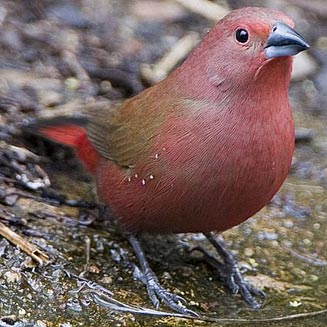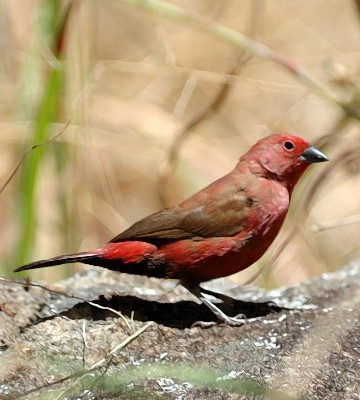
Lagonosticta rhodopareia
SUBFAMILY
Estrildinae
TAXONOMY
Estrelda rhodopareia Heuglin, 1868.
OTHER COMMON NAMES
English: Pink-backed firefinch; French: Amarante de Jameson;
German: Rosenamarant; Spanish: Pinzуn Candela de Jameson.
PHYSICAL CHARACTERISTICS
3.9–4.3 in (10–11 cm). Sexually dimorphic; males bright red on
head, breast, and underparts; females light brown except for
bright red lores. Juveniles similar to females but lack red lores.
DISTRIBUTION
Central Ethiopia south to Mozambique, Zimbabwe, and Zambia.
Discontinuous populations in western Angola and in
southwestern Chad.
HABITAT
Occurs in areas containing both low cover and ample grass including
grassland, thicket, forest edges, bracken-briar, and
thorn scrub.
BEHAVIOR
Found in pairs or small groups. The call is a “ti-ti-ti-ti-ti” or a
softer “tsit, tsit.” The song is a melodious “we-we-we-we-we”
or “weet-weet-weet-weet” with a whistling “feeeee” repeated
several times.
FEEDING ECOLOGY AND DIET
Feeds on or near the ground on seeds of grasses and other
plants, and occasionally on small invertebrates.
REPRODUCTIVE BIOLOGY
The breeding period is at the end of the rainy season and the
beginning of the dry season. The round nest is built by the
male in small shrubs and made of grasses, rootlets, and other
plant fibers. This species is the breeding host of the purple indigobird
(Vidua purpurascens).
CONSERVATION STATUS
Not threatened.
SIGNIFICANCE TO HUMANS
This species has occasionally been kept in aviculture, but never
in great numbers.
Photo Gallery of - Jameson’s firefinch




 Animalia Life
Animalia Life